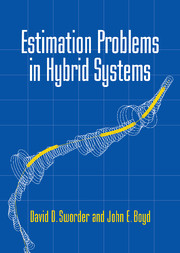Book contents
- Frontmatter
- Contents
- List of Illustrations
- Preface
- 1 Hybrid Estimation
- 2 The Polymorphic Estimator
- 3 Situation Assessment
- 4 Image-Enhanced Target Tracking
- 5 Hybrid Plants with Base-State Discontinuities
- 6 Mode-Dependent Observations
- 7 Control of Hybrid Systems
- 8 Target Recognition and Prediction
- 9 Hybrid Estimation Using Measure Changes
- Appendix 1 PME Derivation Details
- Appendix 2 COM Derivation Details
- Bibliography
- Index
- Glossary
4 - Image-Enhanced Target Tracking
Published online by Cambridge University Press: 17 August 2009
- Frontmatter
- Contents
- List of Illustrations
- Preface
- 1 Hybrid Estimation
- 2 The Polymorphic Estimator
- 3 Situation Assessment
- 4 Image-Enhanced Target Tracking
- 5 Hybrid Plants with Base-State Discontinuities
- 6 Mode-Dependent Observations
- 7 Control of Hybrid Systems
- 8 Target Recognition and Prediction
- 9 Hybrid Estimation Using Measure Changes
- Appendix 1 PME Derivation Details
- Appendix 2 COM Derivation Details
- Bibliography
- Index
- Glossary
Summary
Tracking an Agile Target
One of the most thoroughly studied applications of hybrid estimation arises in the synthesis of tracking algorithms for agile targets. These targets, sometimes intentionally and sometimes inadvertently, have motion paths that make them difficult to follow. One example is that of a piloted vehicle whose location must be tracked from a fixed sensor.
Whereas mobility describes the movement of the vehicle from one location to another in a given period of time, agility describes the vehicle's ability to alter its mean path during that time period.…A major component of agility arises from the driver's intention to maneuver. This is a product of training and the perception of threat. Any analytical approach to modeling a maneuvering vehicle will inevitably encounter a requirement to represent this intentional motion.
[BPL82]The operator of the vehicle exploits its maneuver capability to create a path that he hopes will cause the tracker to lose lock. Such paths have a familiar pattern, with nearly constant acceleration over intervals of unpredictable length followed by discrete maneuver mode changes. Even autonomous platforms can be designed to take such evasive maneuvers; for example, an antiship missile on approach to its objective may follow a preprogrammed jinking path. Such motions often have a constrained geometric structure. If the missile has limited speed control, it will focus its evasive efforts on turning motions, where the acceleration is perpendicular to the velocity.
- Type
- Chapter
- Information
- Estimation Problems in Hybrid Systems , pp. 83 - 116Publisher: Cambridge University PressPrint publication year: 1999

